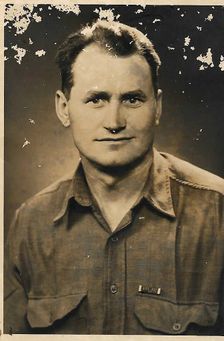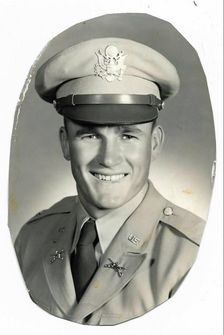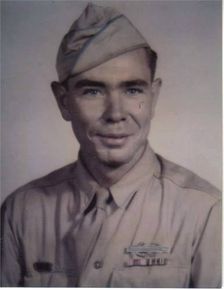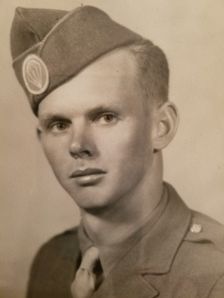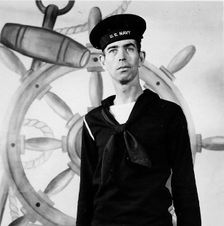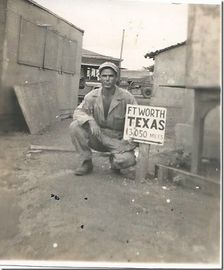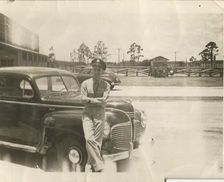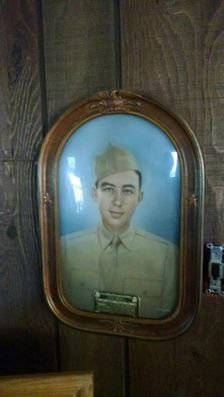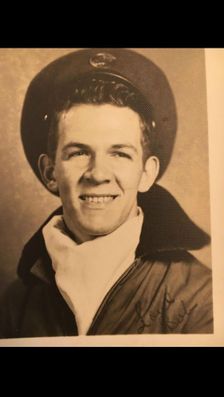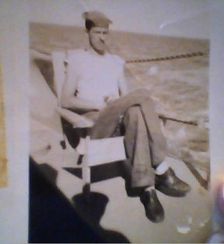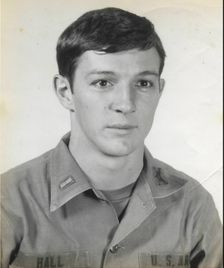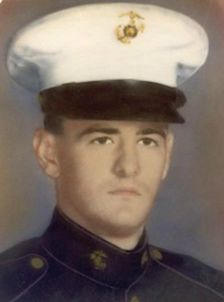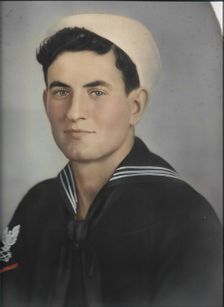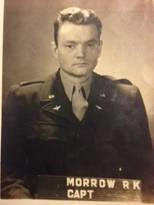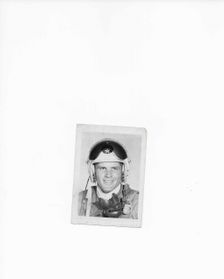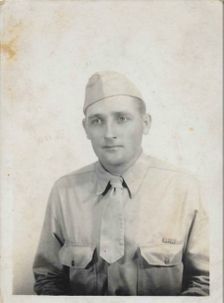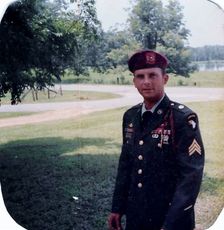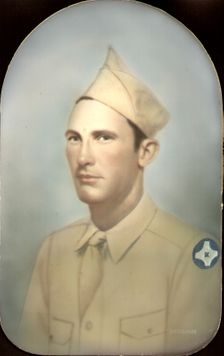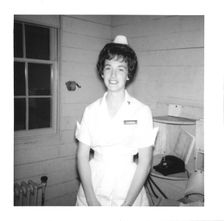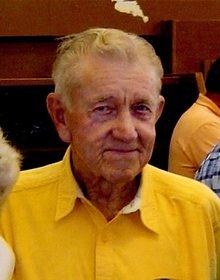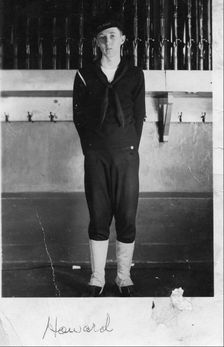Preserving the Past, Providing for the Present and Preparing for the Future.
Red Hill Community Club Veterans Roll of Honor
by the name. If they have since died after their service, there will be a black star
by the name. If, based on current information, the person is till living, there will be no star by the name.
The Roll of Honor will contain brief bios and photos of all of the veterans in our area or from other areas if somehow connected to the community, as we can obtain the information and photos, and have time to post it on the site. Please let us know of anyone that you have information about. They will be posted in alphabetical order by last name. If the person died in combat or while still serving in their respective service, there will be a gold star
Thomas Cecil Atkins
he was sent to France to fight in the campaign in the hedgerows there. He eventually wound up in Germany where a German family kept him from being captured. He was awarded the Purple Heart for wounds received in combat. Cecil died on July 28, 1995.
James Curtis Atkins
1st Lieutenant James Curtis Atkins was the son of Thomas Cecil Atkins. He was born April 8, 1932 and died in a tragic plane crash while serving with the US. Army in Korea on September 21, 1956. He had graduated from Tallassee High School, then went on to Auburn when it was still Alabama Polytechnic Institute. He was enrolled in the ROTC there and was commissioned as an officer in the U. S. Army after graduation. He was trained as a pilot for the L19 Bird Dog observation plane like the one pictured below and had volunteered to fly his commanding officer to a destination in South Korea when bad weather caught them and caused their plane to crash into a mountain.
Clayton, Rufus Alfred
Rufus A. Clayton was born March 17, 1922. He was raised in Red Hill and attended Red Hill School. He entered into active service October 28, 1942 at Ft. McClellan, Alabama- Private First Class Infantry. He did not have to go being he was the man of the house and had two dependants (his mother and youngest sister). He was trained at Camp Barkley, Texas. Before he was to be shipped out, he passed out during inspection. He had pneumonia and was hospitalized and didn’t get to leave with the men he first trained with. Once recovered, he was sent to Camp Bowie, Texas. He served as a medic for a while. He shipped out from New York on October 14, 1944 for the European Theater, arriving October 26, 1944.
Battles and campaigns-Central Europe
Decorations, etc.: American Service Medal; World war II Victory Medal; European African Middle Eastern Service Medal with Bronze Star; Combat Infantry Badge; Lapel Button.
As one of the infantry regiments of the 4th Division, the 22nd Infantry spent eighteen days in November and early December 1944 in the Hürtgen Forest. In a battle many believed mattered little in the big picture, the 22nd suffered 2773 casualties, or 85 percent of its normal complement of 3257 soldiers to take one village and 6000 yards of forest. Each rifle company went into the action averaging 162 soldiers. By the end of the battle, losses in the rifle companies reached an estimated average of 151 percent of their original strength. Although the 22nd Infantry suffered these very heavy casualties, the United States Army's practice of replacing casualties while units were still in combat kept the unit from ever falling below 75 percent strength. Total replacements amounted to 1988 soldiers. Although massive amounts of artillery fire assisted the forward movement of the regiment, the infantry still had to take the ground.
The 22nd Infantry entered the Hürtgen Forest and the regiment fought its way through the woods virtually unsupported in a battle of attrition against three German divisions. Although the 22nd suffered more casualties than any other regiment in the Hürtgen, it lost no ground not immediately recovered. During the battle the 22nd captured 764 Germans. The evidence suggests the regiment kept fighting as long as it contained soldiers who had trained together in the United States or who had significant previous combat experience within the regiment. The backbone of the regiment were the soldiers, officer and enlisted, who had trained together in the United States.
November 23, 1944-Thanksgiving Day was the only day during the 18-day battle that hot rations were served. Turkey sandwiches and luke-warm coffee was carried up to the front lines.
After 18 days the battle in the Hürtgen Forest was over for the 22nd. During the battle, every rifle battalion and company commander was lost, with two companies losing four commanders and another six. At the roll call in Luxembourg, each rifle company had fewer than ten soldiers who had begun the battle on 16 November. Rufus sent letters home during the war, many of them said, “mama please pray for me, please pray that I can live and come home”.
Also he told of walking through Crailsheim, Germany and a sniper shot and killed his Lieutenant who was standing right beside him. When he was in France, he said there were children playing near him in the streets and then fighting began all around; the children ran to a haystack for cover and then the haystack was struck and blown up. He said they would be so exhausted and sleep deprived that while in France, villagers would open their homes to them and they would just fall into beds with their dirty boots and uniforms on-he felt bad about doing that but he was grateful to be able to rest in a bed. He also told of coming face to face with a young German who was wounded, he was thinking how he hated to kill him but his gun was aimed right on him-the young enemy fell over dead so he didn’t have to. Those images and so many more never left him; he relived them so many times. He was on the Rhine River when they got the news the war was over. He finished his service on February 3, 1946 and was discharged at Fort McPherson, Georgia. He never got over the horrors of war and eventually took his own life on October 29, 1950.
Rufus with his nephews Leonard O’Neal Miller and Tom Douglas Miller
Willard Darby
Willard Darby was born on December 17, 1916 and died on August 9, 2007. He married Myrtice Griffith and lived in Red Hill most of his life. Willard served his country in World War II as a U. S. Army Paratrooper. He made 10 jumps during his wartime service. Probably his most perilous period of service was during the Battle of the Bulge in Belgium. This battle lasted from December 16, 1944 to January 25, 1945 and was considered by many to be greatest American battle of the war as Germany made one last frantic attempt to push the allies back to the English Channel.
After his retirement, flowers and shrubs became his hobby and many of his Japanese maples and flowering shrubs can still be seen along the 900 block of Martin Dam Road.
James Preston Graham
James Preston Graham, "Jim," son of John W.D. & Mary Emily Taunton Graham of Red Hill, born 16 June 1907. He grew up in the community, married Jewel Pratt, of Tallassee, and fathered 2 daughters. He enlisted in the Navy during WW2 and served on an LSD in the Pacific. He manned an anti aircraft gun as well as being the ship’s cook.
Griffith, Arvel C.
Arvel C. Griffith was a Tech Sergeant in the US ARMY AIR CORP serving in the China-Burma-India theatre during WWII
He was born on 7/15/1919 in Red Hill, Alabama and at the time of this entry into the Roll of Honor had just past his 97th birthday.
He had been drafted in the spring of 1944, and became one of Red Hill's many contributions to the “Greatest generation.” He reported for duty on the 9th of May, 1944, at Fort McPherson, Georgia. He was assigned to the Army Air Force and sent to Biloxi, Mississippi for basic training. From there he went to Stinson Field near San Antonio, Texas.
He then went to Spokane, Washington for further training in the electrical power distribution needs for military bases. After this training, he returned to Stinson Field, and was given a weeks leave back in Red Hill.
In order to get back to Red Hill he had to ride in an empty freight car on a train that was hauling a car load of high explosives. He and his buddy were placed in the empty freight car that was to prevent the explosives from destroying the entire train by having their empty freight car serve as the separator car from the rest of the train's more valuable cargo, should the explosives detonate. But he and his buddy made it back to Alabama safely and he was able to spend a week in Red Hill with his new bride, Myrtice. Below is a photo of Arvel and Myrtice.
After his week at home he returned to Stinson Field for the beginning of what would be his eventual round the world trip. From Stinson Field, he boarded a troop train for Hollywood, California.
He was able to spend some time at the nearby USO headquarters in Hollywood before boarding the USS General William Mitchell at San Pedro, California. This troop ship took him Hobart, Tasmania, where it docked on Christmas Day of 1944, and remained in port for a few days. He was able to get off the ship and tour the city.
As he was walking the streets of Hobart, a man came up to him and invited him to come home with him and have dinner with him and his family. Arvel accepted his invitation, and still remembers the friendliness that these Australians showed him. He said the man's wife volunteered to write Myrtice for him and tell her about his having had dinner with them and that he was doing well. He was very much appreciative of this family's extension of hospitality and helpfulness to a lonely American serviceman. He had just had about 20 letters from Myrtice “catch up” with him in Hobart, and knew that this lady's letter would be received by Myrtice before any of his letters would.
From Hobart, Tasmania he sailed on to Bombay(todays' Mumbai), India. From there a train took him to Calcutta, then it was up the river Ganges and eventually to his Army Air Force base in northern India. After being there for almost nine months, he remembers the base public address system speakers announcing the surrender of Japan in September of 1945.
Their main task at the base after the surrender of Japan was the disposal of hundreds of C-47s that had been used to “fly the hump” of the Himalayas to ferry supplies to the forces in China. He was given a hammer with a sharp pointed end and had to destroy the glass lenses on all the instrument gauges in the cockpits of these planes. He said he really hated to destroy perfectly good equipment. He actually made himself a working radio receiver from some of the parts he was destroying.
While he was destroying the gauges, other men were removing the engines. After the engines were salvaged, a large pit was excavated for the burial of the remains of the aircraft.
After demolition of the base equipment, they were sent back down the Ganges to the Hugli river delta below Calcutta. There they awaited the arrival of the troop ship General M. L. Hersey.
On Easter Sunday, April 21, 1946 he went to church on the banks of the Hugli river in India. They had set up a church service for those who wished to attend, with a preacher from Texas conducting the service.
They had to wait for the tide to come in before the General Hersey could get up the river to their staging area.
From the banks of the Hugli river in India, they sailed to Colombo, Ceylon (today's Sri Lanka) where they picked up more troops headed for home.
They left Colombo on April 28, 1946, went through the Suez Canal, with a stop in Alexandria, Egypt, and then on through the Mediterranean, passing Gibraltar, and arriving in New York on May 21, 1946.
Upon arrival in New York, it was discovered that the trains were on strike. He said he never liked unions from that point on in his life.
But the Army Air Force came to his rescue, putting the troops on a bus, with a baggage truck following along behind it, and carrying them to Atlanta.
His brother-in-law, Woodson Ingram, his sister, Dallie Griffith Ingram, and his wife Myrtice drove to Atlanta to pick him up.
His homecoming with his wife had to be a wonderful event and he was back in Red Hill, Alabama by the end of May, 1946, from a two-year long trip around the world, becoming, as far as we know, the first person from the community to do so.
Griffith, Elbert
He was born on 7/15/1919 in Red Hill, Alabama and died here on ______
He had been drafted in the spring of 1944, and became one of Red Hill's many contributions to the “Greatest generation.” He reported for duty on the
Griffith, Edmond Terrell, Sr.
EDMOND TERRELL GRIFFITH, SR., served in the Civil War with Company F of the 13th Alabama Infantry, CSA.
He was born September 11, 1843 in Meriwether County, Georgia. He enlisted in the 13th Alabama Infantry in 1861. He lost an arm in the Gettysburg battle in July of 1863, spent some time as a prisoner of war before taking the oath of allegiance to be paroled. He made the long arduous trek back to Red Hill, then called Channahatchee, He married Missouria Mullins sometime in 1865 and raised a large family. It was said about him that he could pick and shuck more corn with one arm than most people could with two. Arvel Griffith, described in a bio above, is one of his grandsons. He died April 18, 1918, in Channahatchee(Red Hill) and is buried in Refuge Cemetery. Below is a pic of him and his family in the late 1800's.
Griffith, Othan H.
He was born in Red Hill, Alabama on October 11, 1924 and was killed in action at the age of 19 on July 24, 1944.
His body was brought back and buried in Refuge Cemetery sometime in 1946
Hall, Mikeal Edward
Mikeal Edward Hall was a 2nd Lieutenant in the United States Army, serving in the Vietnam War, assigned to the 11th Calvary, and receiving a Purple Heart and Bronze Star. He was the son of the Rev. Edward and Nita Flurry Hall. He died as a result of a construction accident while working on a seawall on Lake Martin on November 18, 2005.
Mike and his troops.
Hudson, Jimmie Dale
Jimmie Dale Hudson was a Lance Corporal in the United States Marine Corps, Company 3 of an Engineers Batallion, of the 3rd Marine Division. He had been in the Marines for only 9 months when his outfit was sent to Vietnam. This outfit's job was to find and destroy the land mines so prevalent in the battle areas. Only a short time after arriving to serve his country in the Vietnam War, he stepped on an undetected mine, which killed him instantly at the age of 22 on November 23, 1966.
He was the youngest son of J.T. and Hattie Bell Hudson. He was born May 24, 1944 and grew up in Red Hill. He attended Red Hill School and then graduated from Elmore County High School in Eclectic.
As the saying goes,"all gave some, some gave all." He gave all the life he might have experienced beyond the age of 22 because he consented to his country's call. His name is only one from Red Hill on the Vietnam Wall in Washington, D. C.
Thank you for your service and sacrifice, Jimmy!
Johnston, Herschell
Herschell Johnston, one of the few remaining living members of our Greatest Gerneration in our area, served in World War II in the Navy in the South Pacific theatre. He operated a Higgins boat, or LCVP, during the Tinian, Saipan and Okinawa campaigns. General Eisenhower stated that Andrew Higgins won the war with the boat he invented. Herschell would transport boat loads of Marines onto the beaches and then do a return trip to the troop carrier ship with dead and wounded Marines. Many times the Marines on the return trip would be some of the same ones he had just previously brought ashore, either wounded or just been killed in the fighting on shore. Herschell stated that Okinawa was a particulary rough campaign, with its extremely high casualty count. Below is a Higgins boat with its load of Marines disembarking on to the beach.
Morrow, Robert Kline
He was born on 6/25/1919 in Harrisburg, Pennsylvania and died on 10/28/1979 in Montgomery, Alabama.
He graduated from the University of Alabama in 1942. Shortly after his graduation he was commissioned in the United States Army Quartermaster Corps. He was later transferred into the United States Army Air Corps. He was then stationed at Army Air Corps bases all over the Midwestern and western United States. His assignments had to do with the acquisition and shipping of supplies to soldiers overseas since he had a degree in Transportation. He resigned his commission in 1946 to go into private business. He was later a member of the Air Force Association.
He spent well over half his life in the South and did not like to be called a Yankee. He married Doris Jordan, daughter of Belle Kennedy Jordan, who had also enrolled in the University of Alabama. They had met in 1940. They were married on May 25, 1942, before he went on to his first assignment. She remained behind to finish her education. Later on, his younger brother became a career Marine and even later on his son became a member of the Green Berets.
After the war he spent much of his time in Red Hill, Alabama since that was where his mother-in-law, Belle Kennedy Jordan lived. He came to love the Red Hill and Lake Martin area and is buried in the Refuge Cemetery.
Munsch, Albert S. Jr.
He was primarily a tactical fighter pilot, later serving as Air Operations Officer. He closed out his career of service to our nation with the 426th Tactical Fighter Training Squadron.
During his years of service he was awarded the Silver Star 3 times, The Distinguished Flying Cross 9 times, the Air Medal 37 times, the USAF Outstanding Unit Award 4 times (3 with “V” for valor-combat awards, the USAF Longevity Award 5 times (1 for each 4 years of service), the Combat Readiness Medal 2 times and the National Defense Service Medal 2 times.
3 9 37 5 2 4
Additionally he received the Purple Heart, Commendation Medal, Armed Forces Expeditionary Medal, Vietnam Campaign Medal with 5 campaign stars, Vietnam Cross of Valor with silver star, Vietnam Service Medal, Presidential Unit Award, USAF Small Arms Expert Ribbon and the Vietnam Cross of Valor with palm- a unit award.
He spent 8 yrs after retirement in Okinawa flying darts in F86 for USAF.
He loved flying and did some crop dusting in Arizona after retiring from the USAF. Upon his death he was brought to Refuge Baptist Church Cemetery and laid to rest next to his son, Albert S. Munsch, III.
Norris, Walter W.
Walter Norris was a Private serving in the United States Army during WWII in the Italian campaign. He was in the Infantry and spent much of his time in the Bari area of Italy. This was the area on the Adriatic coast that was mistakenly bombed by our own bombers. The bombs hit a cache of mustard gas on the loading docks in the Bari harbor that sent the gas out among our own GIs in the area. The incident was kept secret for many years after the war.
He was awarded the Purple Heart. He lived most of his life in the Walker County and Birmingham area of Alabama after his service to his country.
Age related health problems brought him to the Veterans Home in Alexander City, Alabama. This move in turn brought his daughter and son-in-law, Willette and Tommy Lyle, to purchase a home in Red Hill to be close by to him. They chose to honor him by having his name engraved on the RHCC Wall of Honor
Sharpston, Anthony E.
Anthony E. "Tony" Sharpston served his country as a sergeant in the United States Army in the Desert Storm campaign. He was a sniper and won the Bronze Star for his performance in that action.
Taunton, Martin Alva
My dad, Martin Alva Taunton, was drafted in late 1944 or early 1945. He was working for Palmer Taylor driving a log truck when, in unloading the truck, a log fell on his ankle breaking it. His enlistment was postponed then until his ankle healed. He enlisted into the Army at Ft McClellan on 15 Jun 1945, “for the duration of the War or other emergency, plus six months, subject to the discretion of the President or otherwise according to law” and was posted to Ft Benning for Basic Training. I recall his telling me he was at Ft Gordon (Augusta, GA) at some point. Later posted to Camp Blanding in Florida, he reinjured his ankle there and then was discharged on 5 Dec 1945.
I have attached some photos of him in uniform. In the one with my mother, Burte Taunton, she is pregnant with my youngest sister,Kay.
Submitted by Charles Taunton, son of Martin Alva Taunton,on September 20, 2016
Taunton, Roma Lee
Roma Lee Taunton is a native of Red Hill, the daughter and first child, of Martin Alva and Bert Taunton. She attended Red Hill School through the 9th grade. After high school in Tallassee, she earned a diploma at the Birmingham Baptist Hospitals School of Nursing (now the Samford University Ida V. Moffett School of Nursing), and was licensed as a Registered Nurse in 1959. She topped a life-long-learner career path with a University of Kansas Doctor of Philosophy Degree in 1983. She served this country during the Berlin Crisis as a 2nd Lieutenant in the US ARMY Nurse Corp assigned to the National Guard
She served as 2nd Lieutenant from 1960-1962 in the Army National Guard, 109th Evacuation Hospital, Birmingham, AL. President Kennedy activated her unit for the Berlin Crisis on October 10, 1961.
Arriving for Duty
She was assigned to Fort Polk, LA, which had been closed since the Korean War. She served on active duty as a US Army nurse from October 15, 1961 to July 15, 1962.
Snow in Louisiana!
Along with a MASH unit from Mississippi and a General Hospital Unit from Florida, they supported a tank battalion from Texas in reopening the post.
Setting up the hospital facility.
In addition to re-establishing and staffing the base hospital to provide care for the soldiers and their dependents, they participated in field manoeuvres required to qualify their EVAC Hospital for combat readiness.
109th Field Exercise: Moving Out
Rufus Edgar "Bo" Jordan
Rufus Edgar "Bo" Jordan grew up on his family's farm in this area in the Great Depression. After completing high school and two years at Alabama Polytechnic Institute (Auburn), he enrolled in the Army Air Corp Flight School. He graduated from Flight School in December of 1941, five days after the attack on Pearl Harbor. He was eventually sent to Australia where he flew 151 combat missions as a fighter pilot, primarlily flying the P-40 Tomahawk in the Pacific Theatre. His decorations included the Silver Star, Distinguished Flying Cross and Air Medal. The day after he returned home he married his college sweetheart, Sarah Abrams. They were married for 60 years and raised five children. After retiring from the USAF in 1952, he farmed for a few years. He then began his own business as a marine shop operator which he continued for over 50 years. He was 93 when he died on September 25, 2013.
Walls, William Howard
Howard Walls was the son of Oscar Walls. His mother died not too long after he was born and he wound up being raised by Felicia Taunton Darden Walls Hall, an aunt by marriage to the author of this tribute to him, Raymond Eugene Hall, and an aunt by birth to Charles Taunton, who so graciously provided much of the information for this tribute. He was also a brother to Jewel Walls Bush and Milford Walls.
He enlisted in the Navy sometime in 1942, took basic training in California, and wound up being assigned to the USS Birmingham just prior to the Battle of Leyte Gulf. During this battle A US aircraft carrier, the USS Princeton, was hit by a Japanese torpedo and was burning. The Birmingham pulled alongside the Princeton to give aid. Howard was one of the crew on the deck of the Birmingham fighting the fire on the Princeton when the magazine on the Princeton exploded, killing most of the Birmingham’s firefighting group, which included Howard. He was buried at sea. His name is listed in the Tablets of the Missing at Manila American Cemetery, Manila, the Phillipines. He was posthumously awarded the Purple Heart.
His name last appears on the Birmingham’s Muster Roll dated 09/30/1944. An account of the disaster is included in a letter from his commanding officer, Captain Thomas B. Inglis, to his father, Mr. Oscar Walls, that follows below:
Mr. Oscar Walls, Rt. 1
Tallassee Ala.
My dear Mr. Walls:
I presume that long before this letter reaches you, you will have received the official notification of the death of your son, William Howard Walls, S 2/C, USNR. Although I realize that there is little that I can say to relieve your sorrow at this time, I am taking the liberty of writing this personal note to extend my deepest sympathy and sincere regrets, in which all his shipmates join me.
William was one of the best liked men in the ship's company. He had a sense of humor all his own and never failed to brighten any gathering. His conduct and his work were always above reproach. I shall miss him greatly.
William's death was caused by an explosion which occurred while this ship was fighting a fire on one of our aircraft carriers resulting from an enemy bomb. His death was instantaneous and without suffering. It is my earnest hope that you will take comfort in the fact that he died as a brave man in the service of his country, not only in the midst of combat with the enemy, but while this ship was on a mission of attempted rescue.
Your son's remains were buried at sea on Oct. 24, 1944, with appropriate religious burial services conducted by the ship's chaplain, Lt. Comdr. Abbot Peterson, Jr., ChC., USNR. His funeral reverence and honor on the part of all his shipmates could not have been greater. In addition to these services, a memorial service was held on November 4, 1944, with full military honors and with the entire ship's company in attendance.
His personal effects have been carefully inventoried and will be shipped as soon as practible for further delivery to you.
If there is anything further that any of us can do at any time we are only anxious to serve you. Please feel free to call upon me.
Again please be assured of my deepest sympathy in your sorrow, a sorrow which I too, share.
Very sincerely yours,
Thomas B. Inglis, Capt.
U. S. Navy, Commanding
The explosion that took the life of Seaman Walls also took the life of 228 of his fellow seaman as well as severely wounding the Captain Inglis who wrote the above letter to his dad.
Comments
Fran Larson
04.05.2022 17:40
I hadn't visited your page in a while. This is truly a labor of love....such detail. I think it will mean a lot to the community!
Marvin Brown
05.08.2019 10:23
It seems something really interesting to me which I am gonna share with my brother after mine https://www.goldenbustours.com/grand-canyon-tours/
Raymond Eugene Hall
05.08.2019 14:14
Which person were you referring to, Marvin?
Paula Castleberry
24.05.2019 18:39
As I read over these today (5/24/19) I was both puffed up with pride and brought to tears. Very appropriate for this Memorial Day weekend. Good job Ray.
“Pete” Corrado
23.10.2018 16:21
My dad, James Preston Graham, grew up in Red Hill and served in the US Havy during WW 2. How do I get his picture posted?
Raymond Eugene Hall
23.10.2018 18:45
Thanks , Pete! Put your pic in the email to me or attach a pic to the email to me at redhill1@elmore.rr.com. bio on him if you can. I will place him on the site and advise you when it is posted.
Michelle Singleton Bowman
08.05.2018 21:13
Not sure if family or not my father is Bobby Jean Singleton June 1 1942 his father Woodrow H Singleton (pop) I know many of family members are in Tn and Al my mother is Maxine Florence Singleton thank
Ray Hall, RHCC Web Manager
09.05.2018 00:21
Michelle:
Is he mentioned on our site or does he need to be mentioned. Let us know if we need to mention them and the information to post. Thanks for taking the time to comment.
Shelby Griffith Rodgers
21.05.2017 00:57
My dad, William Elbert Griffith, is listed in here although there is not much information about him. I would be glad to write something for you.
Scott Placek
29.05.2018 03:30
My great-uncle Elbert! I hope you can add something!
Ray Hall, RHCC Web site manager
09.05.2018 00:23
Shelby:
I would love to post the additional info about Mr. Elbert!
Tami Rodgers Wilson
20.05.2017 13:48
This is just amazing. My grandfather Elbert Griffith is in this and his brother Othan Griffith. Lots of other relatives also. Thanks!!!
Arthur Donald Ballard
09.05.2017 17:18
Saw a picture of my best friend in high school. JAMES ATKINS. Killed in plane crash in Korea.
Betty Munsch Dayton
28.10.2016 20:41
Thanks for doing such a great job in my husbands contribution to the Wall of Honor. What a nice way to show respect and honor to those who served and have passed on.
Paula
03.10.2016 15:22
Reading this is an emotional experience. I am thankful for each of these men who served our country and some of them died for our country. This is great history.
Paula Castleberry
15.09.2016 20:24
This is so good and very interesting. Ray Hall has done a good job with this.
Latest comments
04.05 | 17:46
I love quotes! Outstanding and encouraging!
04.05 | 17:43
I don't see your wonderful books mentioned! Where are they?
04.05 | 17:40
I hadn't visited your page in a while. This is truly a labor of love....such detail. I think it will mean a lot to the community!
28.01 | 04:07
Deborah, welcome to the neighborhood. I hope to visit you soon.
Share this page
